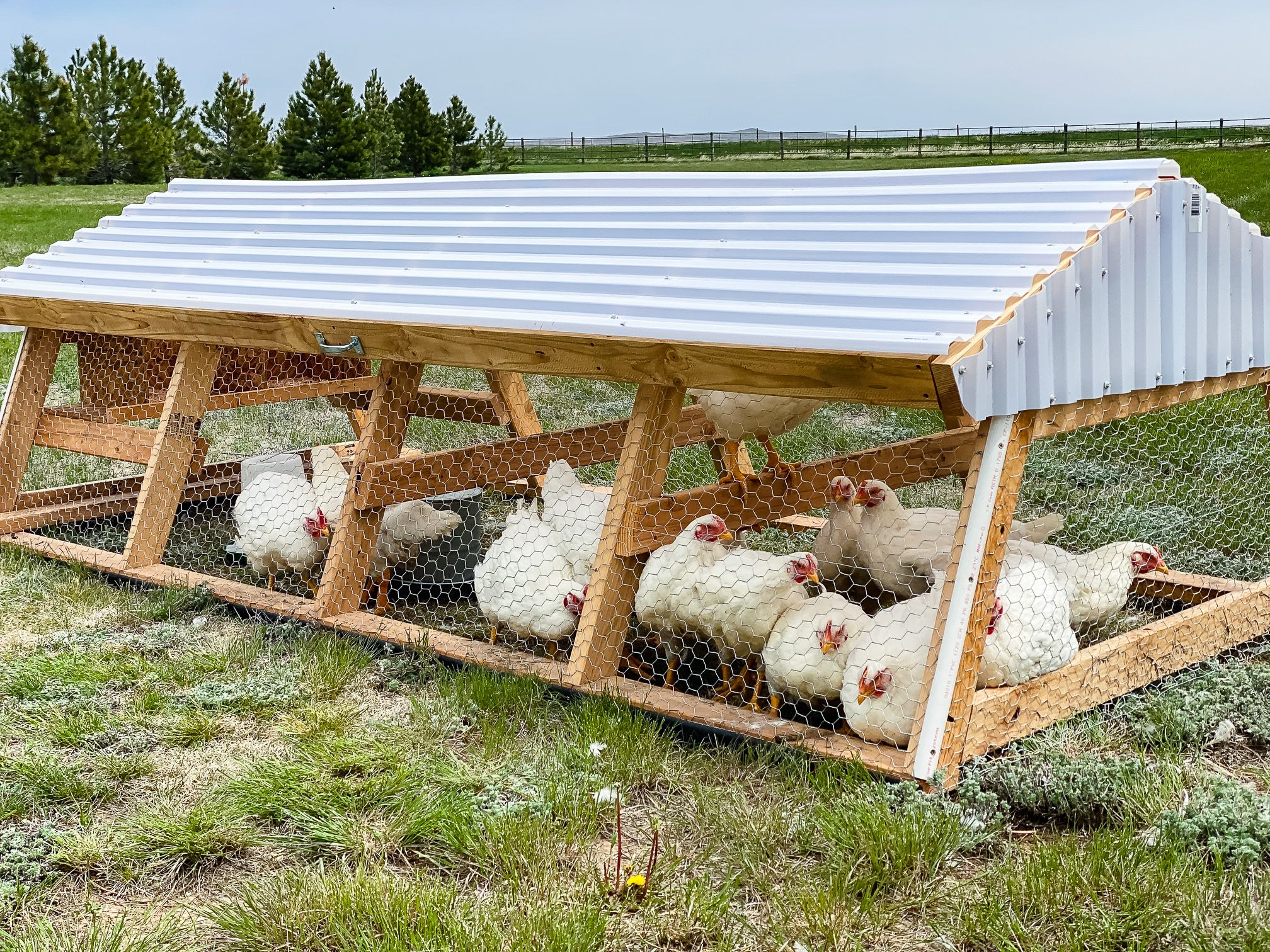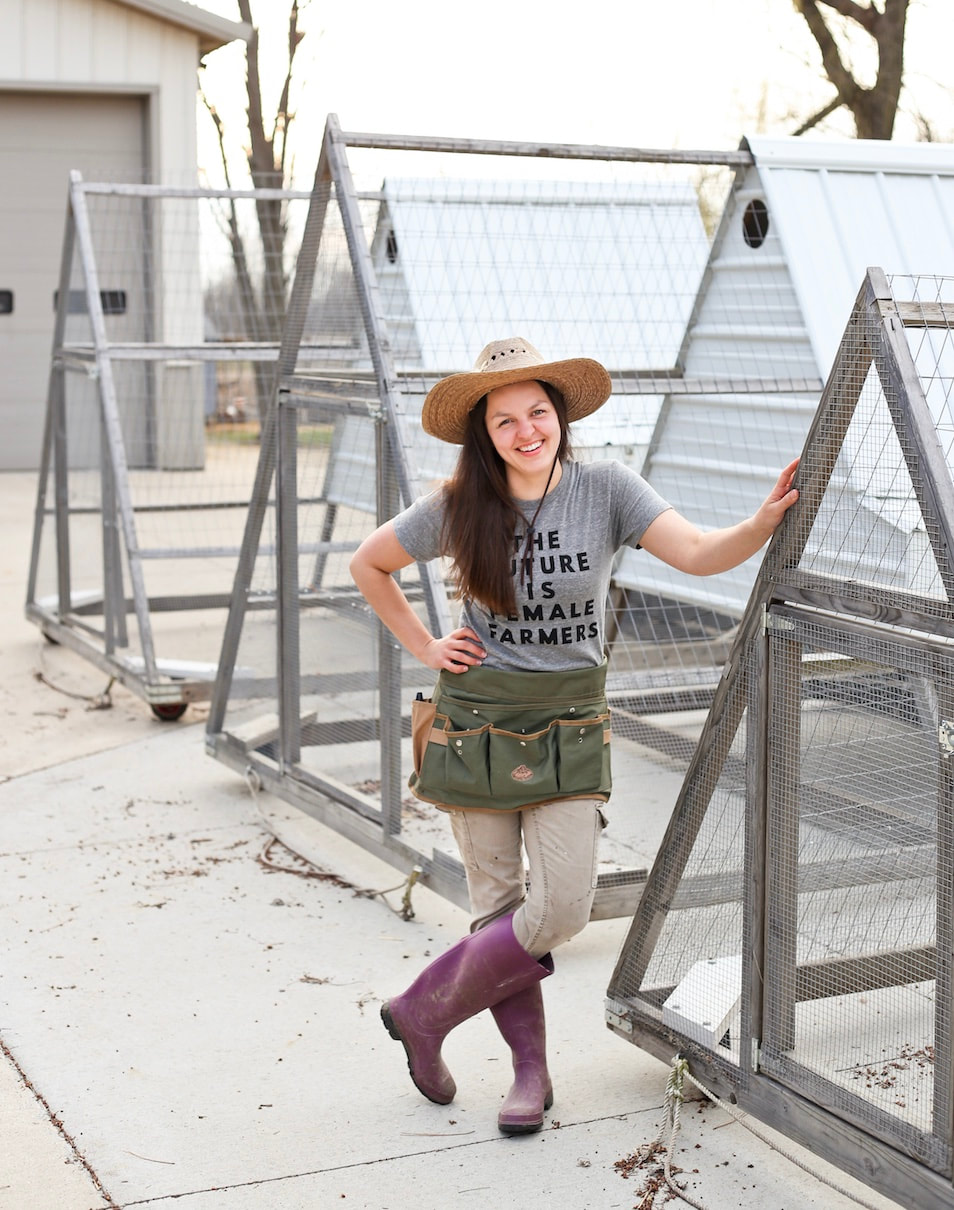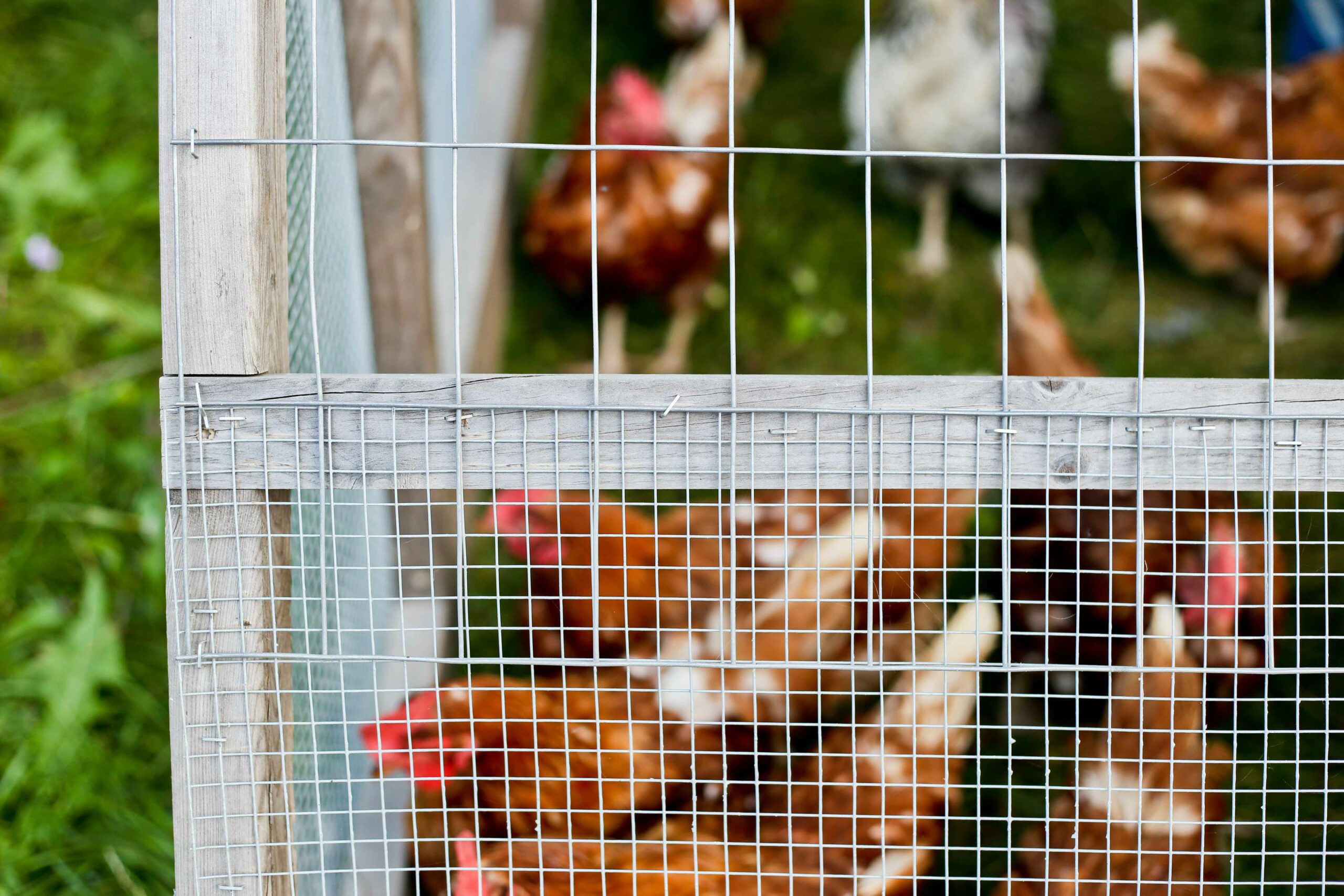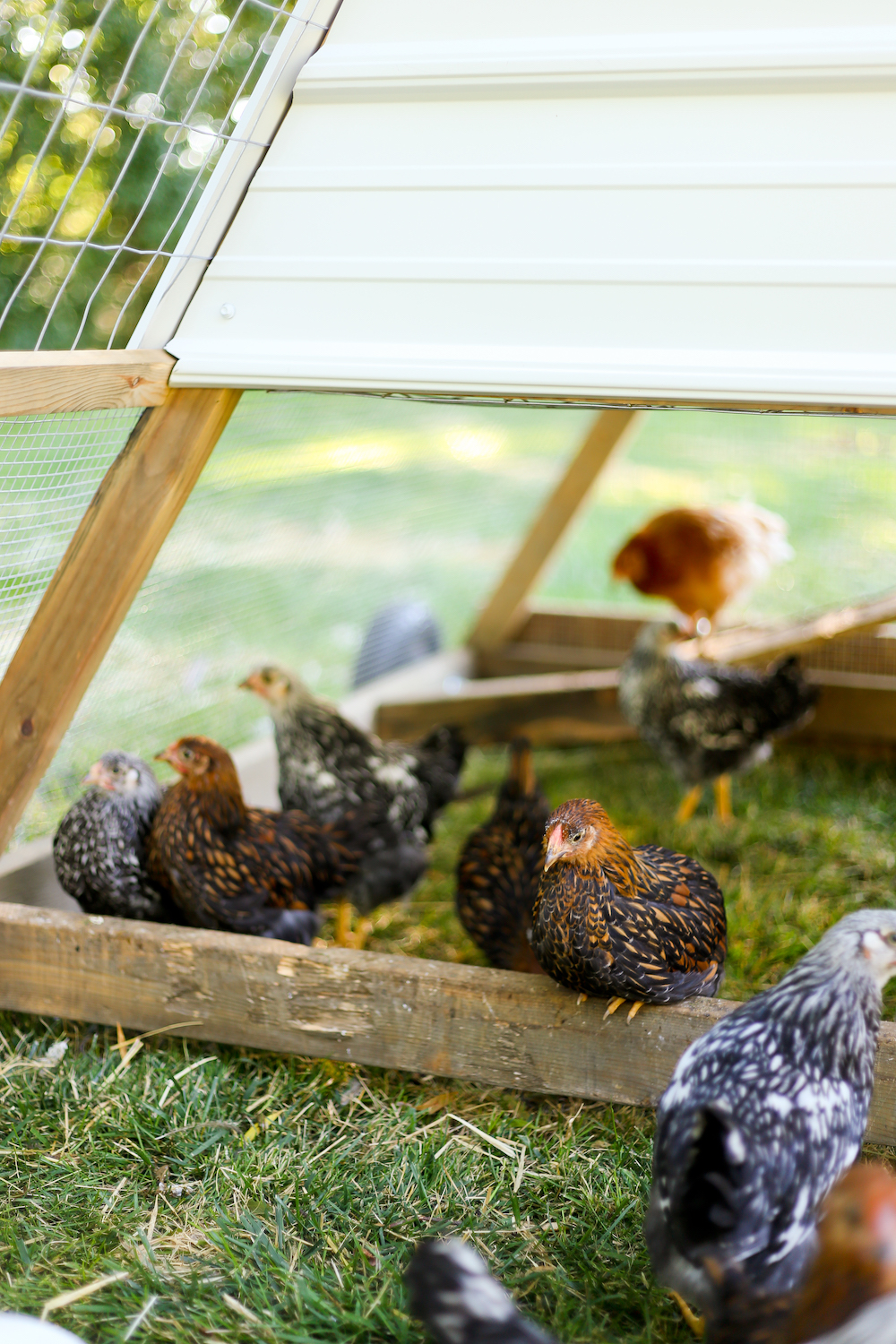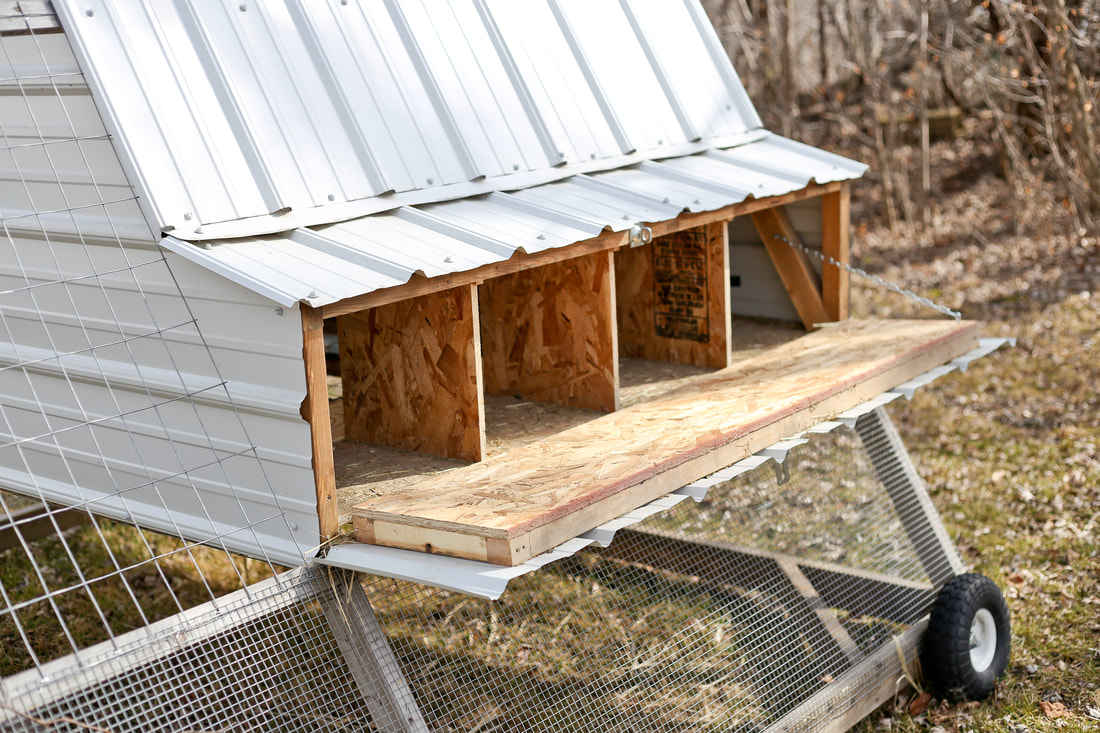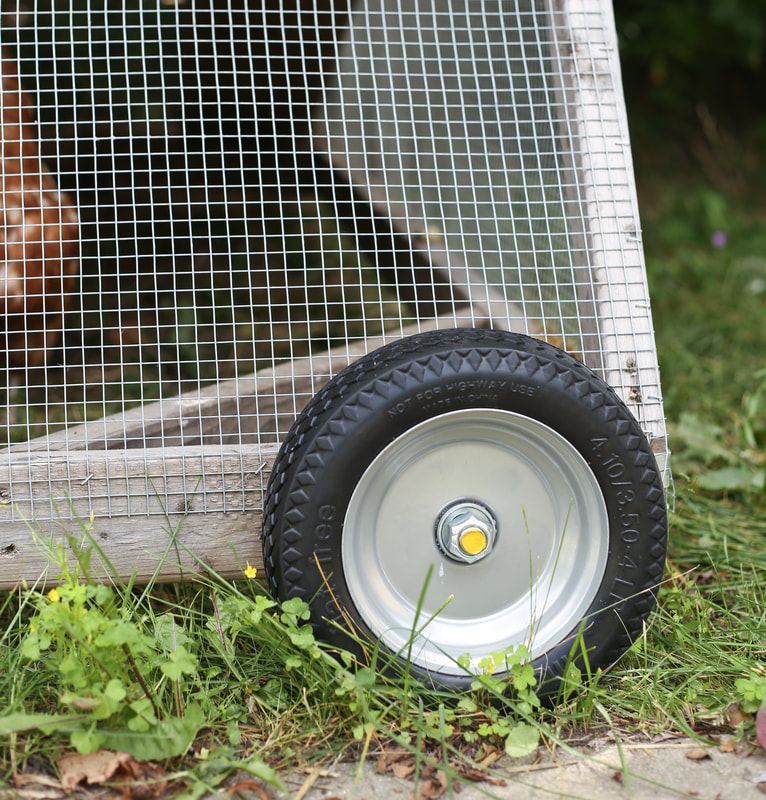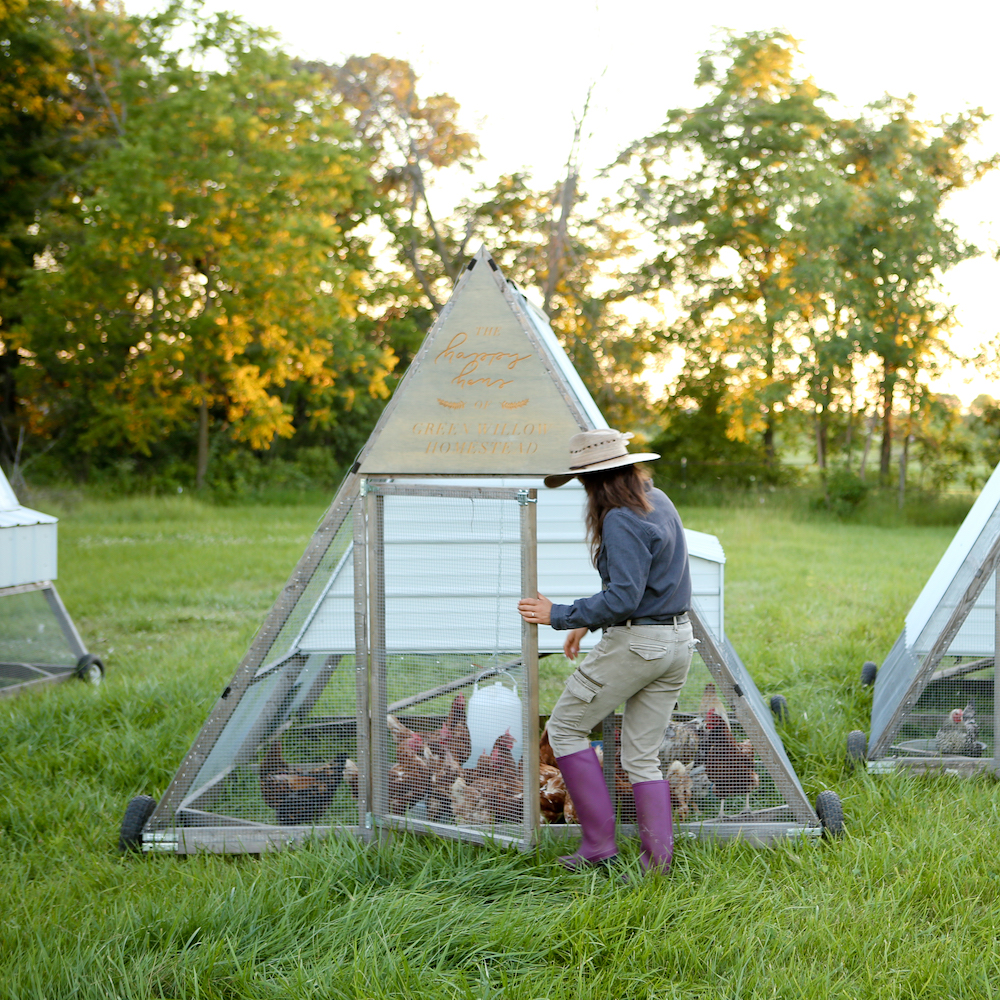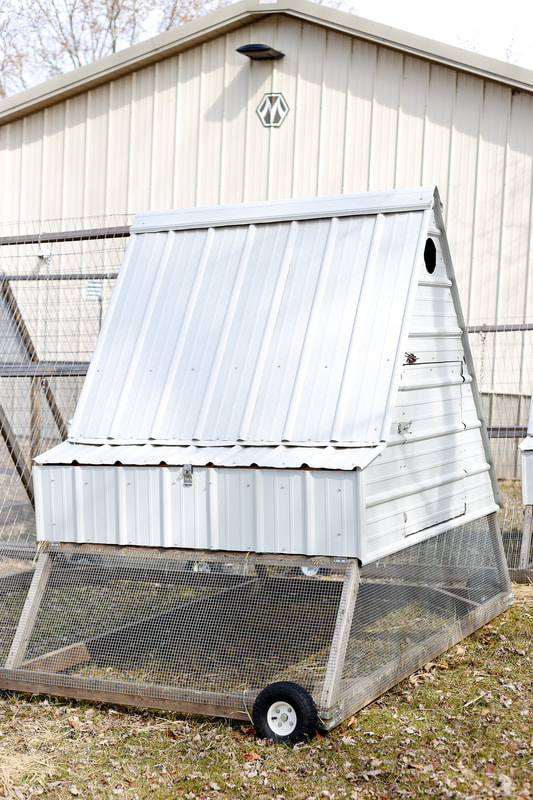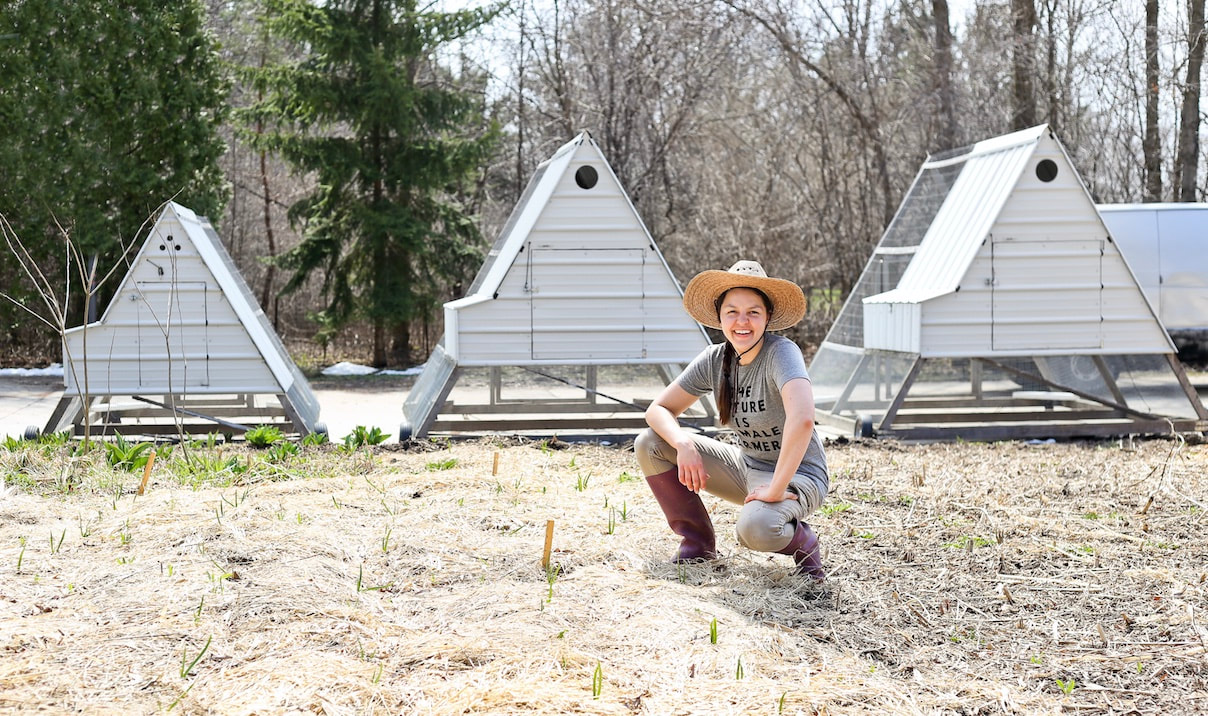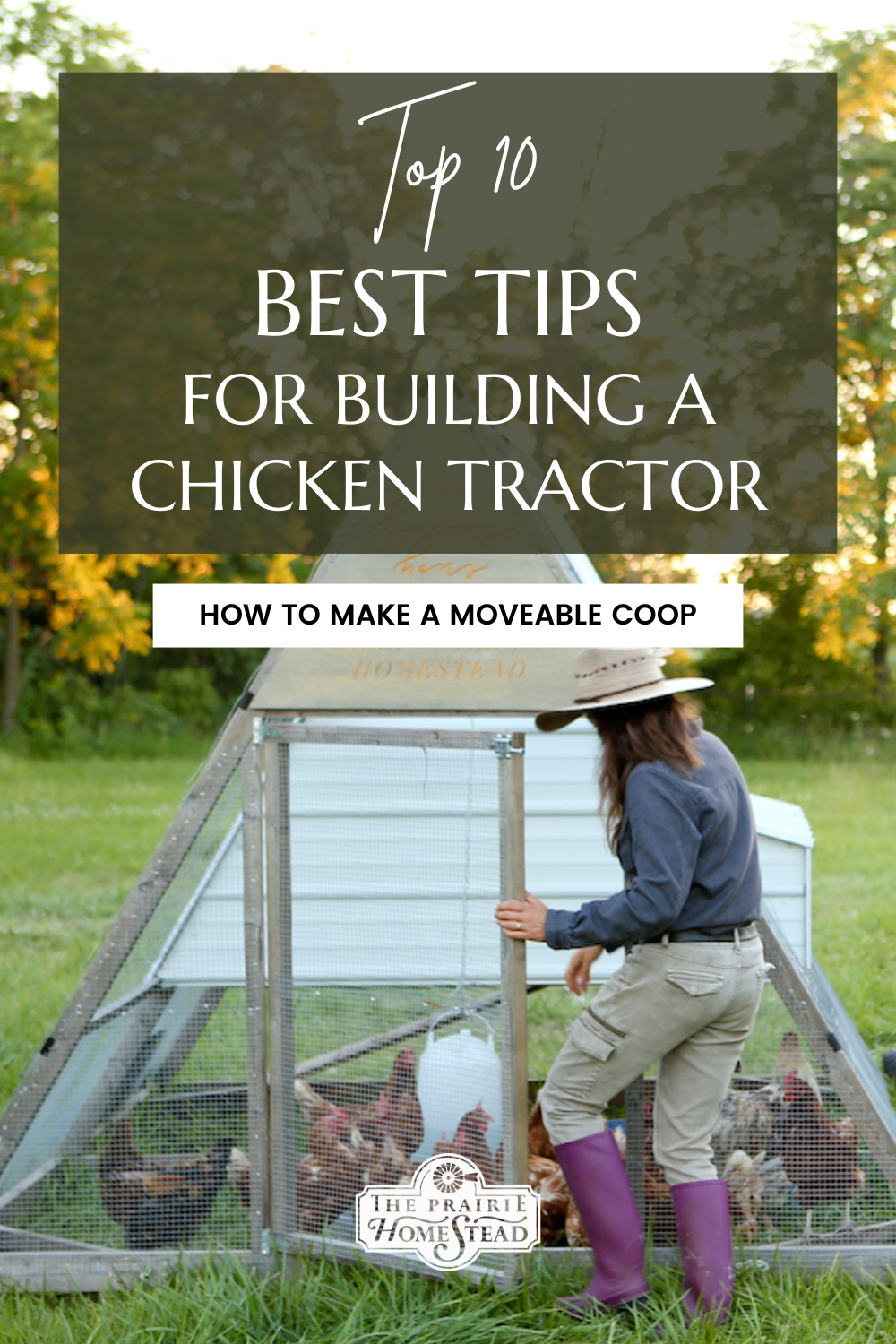[ad_1]
I’ve become a huge fan of chicken tractors in recent years.
A few years ago, I shared about how I’ve been changing my relationship with our chickens on the homestead. I’ve been shifting my viewpoint from seeing chickens as a chore and instead thinking about various ways to use the natural inclinations of a chicken to minimize our work load.
One of the ways to use a chicken to minimize the work on a homestead is to use them as part of your pasture setup by putting them behind grazing animals to spread their manure and remove insects. This is best done with a chicken tractor set-up (aka mobile coop), as it’s hard to get chickens to stay where you want them to stay (they are rebels).
And bonus: by using a simple chicken tractor, you’ll not only save on chicken feed costs, but you’ll also give your birds new scenery and fresh air while keeping them more secure from predators.
I still plan on sharing my chicken tractor plans with y’all someday (our chicken tractors look like the image above), but with a combo of being in a currently-busy stage of life right now (listen to this podcast episode for more details) and also with my upcoming NEW book Old-Fashioned on Purpose coming to shelves soon, I keep putting my chicken tractor plans on the back burner.
Fortunately, I recently had the opportunity to chat with Kelsey Jorissen Olesen from Green Willow Homestead Blog and The Positively Green Podcast about homesteading and she offered to share some of her best tips about using chicken tractors. She has some great tips to share with all of us below!
~Jill
Are you considering building a chicken tractor for your flock of chickens?
Chicken tractors have become increasingly popular thanks to their ability to move across your lawn or pasture, provide tons of fertilizer, and give your hens protected access to nibble on plants and bugs.
While it may seem like building a chicken tractor for your backyard flock may be straightforward, there are a lot of considerations you need to make in order to keep your hens protected from predators as well as make your daily chores a breeze.
So in this post, I’m going to share with you the top 10 most important things to know when building your first chicken tractor.
Before I dive in, let me quickly introduce myself! My name is Kelsey Jorissen Olesen, and I’m the farmer behind the Green Willow Homestead Blog. My husband, Paul, and I own 80 acres of farm paradise in Northwest Wisconsin, where we raise laying hens and dairy goats as well as grow tons of market vegetables. Paul is an engineer and general contractor who constantly makes my DIY farm dreams come true.
One of our very first homesteading projects was designing and building the internet’s most popular A-frame mobile chicken tractor. Our chicken tractor build plans have been featured on Bob Vila, Countryside Magazine, Meyer Hatchery, ModFarm, ACRES USA, and Fresh Eggs Daily.
So, needless to say, I’ve been around the block on what makes a chicken tractor durable, reliable, and pretty to look at!
Let’s dive in…
Top 10 Tips for Building a Chicken Tractor
Tip #1: Have Enough Ventilation and Shade
No matter what the temperature is outside, your hens need proper ventilation so that humid and moist air can rise and escape where they are residing. In the summer, keeping your hens out of direct sunlight during the day and having their roosting area offer enough venting at night is extremely important for their respiratory health. During the winter, lingering humidity can cause frostbite on your hens’ wattles and combs, leaving them susceptible to infection.
That’s why I strongly recommend that you have an open-air bottom below your roost during the summertime protected by 2×4” welded wire fencing as well as ventilation holes at the highest point of your tractor. The welded wire fencing allows manure to drop through to the ground as well as air to vent inward and upward.
As for shade, offering a spot for your hens to take cover that isn’t inside their roosting area is important. On our chicken tractor design, we have ample space below the roosting area for hens to seek shade from the hot summer sun.
Tip #2: Have Enough Protection from Predators During the Day and at Night
Seasoned chicken owners know that the time of day determines what predators your hens are up against. When the sun is up, your primary concern is aerial predators like hawks, eagles, and falcons. At night, ground predators become more of a threat, like coyotes, raccoons, opossums, bears, and weasels. With two different groups of predators, I suggest a two-pronged approach for building your chicken tractor.
First, use heavy-duty 2×4” welded wire fencing that you staple onto your chicken tractor frame and reinforce it with ½” hardware cloth along the bottom. Be sure to zip-tie the two styles of fencing together for added protection. Don’t use chicken wire fencing, I beg of you – that stuff is so flimsy and puts your hens at risk.
Second, when your hens roost at night, make sure you build something that you can completely seal up so ground predators can’t weasel their way in. In our design, we have a ramp on a pulley system that shuts the hens up at night. This system also keeps the birds shut up tight in the late evening or early morning, allowing you to move the tractor without having birds in the way. This is very important when they are small!
Tip #3: Be Prepared to Move It Every Day
When planning out your chicken tractor and daily chores, I’ve found that moving the tractor one space daily allows for the least amount of chicken manure buildup. Chickens poop all day and all night, making it hard for them to continue foraging in the same spot after 24 hours. This also keeps your grass or pasture from burning up due to the excess nitrogen in the chicken manure.
Tip #4: Pay Attention to Your Pecking Order
While I wish that chickens weren’t as petty as they actually are, nothing can stop nature. Over the years, I’ve found that some flocks have a scapegoat that the group will pick on, and when that flock is inside a chicken tractor, it can ramp up since the victim doesn’t have many places to hide. By pecking, pulling out feathers, and fighting, certain hens assert their dominance. Sometimes this happens just once to establish the pecking order, and other times it can be a chronic issue.
There are a few ways to approach a pecking order issue. First, you can figure out who the bully is and remove them from the tractor. Second, you can remove the victim(s) and find them a new place to call home. Third, you can try out a rooster! While this may seem counterintuitive, I’ve found that good roosters keep the peace among their flock by breaking up fights. Getting a rooster for your tractor is a gamble, as over-mounting can become an issue.
Tip #5: Make the Roosts Higher Than the Nesting Boxes
Another funny quirk another hens is that they always want to roost in the highest place possible. This instinct keeps them safe by allowing them to sleep far away from ground predators who lurk at night. When you set out to design and build your tractor, make sure to put the roosting bars higher than the nesting boxes, or you’ll have hens nesting (and pooping) inside those boxes and not on the roosts.
On our chicken tractor, we implemented a diagonal roosting bar that sits higher than the nesting boxes and allows for the most amount of hens to roost without crowding.
Tip #6: Create Exterior Nesting Box Access for Gathering Eggs
Speaking of nesting boxes, when it comes to the easiest workflow for your farm or homestead chores – exterior access to nesting boxes is a must. Not only does it make chores go faster, but you don’t have to step in and out of your chicken tractor and risk letting a few pesky hens out.
When it comes time to do an annual cleaning of the tractor, exterior nesting box access also makes that process a whole lot easier.
Tip #7: Implement Heavy-Duty Tires and Hardware for the Mobility of the Chicken Tractor
A chicken tractor wouldn’t be mobile without good quality tires and hardware to keep those tires working properly. When setting out to build the most durable chicken tractor, we went through numerous designs until we found the one that allowed for smooth turning and moving. You may think it’s easy to slap on four tires and get a chicken tractor moving, but there is a good amount of physics and understanding of load capacity that goes into tire selection!
We found that having a set of castor wheels up front to allow for pivoting and a set of flat-free tires in the back make for the best mobility setup. As a 135-pound female, I can easily move our largest model of the chicken tractor (I even did it 8 months pregnant!).
Tip #8: Have Human-Sized Access Doors for Vet Care, Maintenance, and Chores
While you may be tempted to make your chicken tractor only have chicken-sized doors, I want to caution you. Trying to perform vet care becomes increasingly difficult when you have to get to a single bird with no proper access. You’ll end up letting your whole flock escape if you aren’t careful. Then throw in daily chores; you’ll want to be able to provide water and feed without giving yourself a backache.
With our design, we have a large access door in the front for chores and a large door off the back that allows you to get to the birds while they peacefully roost at night. This comes in extremely handy if you have to clip feathers, do ID tags, or administer medicine.
Tip #9: Use Durable Materials
While this tip may seem simplistic, you’d be surprised what corners you start cutting when you realize the price of good quality materials! Using cheap things like tarps and chicken wire for your chicken tractor are a huge no-no. They never last and end up costing you more in the long run.
On our chicken tractor, we use corrugated metal siding, welded wire fencing, and high-quality hardware to ensure our tractor will stand the test of time and the elements. We also recommend an eco-friendly stain that preserves untreated pine lumber.
Tip #10: Perform Annual Maintenance and Upkeep
Just like having a stationary chicken coop, maintaining the health of a chicken tractor so it lasts and keeps your flock safe is crucial. Annually check your screws, staples, and hinges to make sure they are tight and secure. Do a good pressure wash on the tractor before you roll it out in the spring. While you’re at it, re-paint your roosting bars and nesting boxes to keep lice and mites away. Your flock will thank you in many, many years of delicious eggs!
So those are my top 10 most important things you need to know when building a chicken tractor. If you are curious to learn more about our Mobile Chicken Tractor Build Plans – keep reading!
The A-Frame Mobile Chicken Tractor Build Plans
Our Mobile Chicken Tractor Build Plans are downloadable, printable, and come with all the information needed to get started:
- A materials list with links to specific items you’ll need.
- 40+ pages of step-by-step instructions with detailed diagrams, drawings, and pictures.
- A bonus section with tips and tricks we implement to make the tractor work to our benefit.
We then batch-built three A-frame chicken tractors over the course of a month. A single tractor will take, on average, 20 – 24 hours of construction time based on skill level. While most of the tractor can be built solo, a second set of hands will definitely make a handful of steps much easier.
We offer three different sizes depending on the size of your flock. Click through and keep reading for all the specs!
Got questions? Head over to our FAQ Page here.
Thanks so much for reading, and best of luck building your flock their first chicken tractor!
-Kelsey Jorissen Olesen
Green Willow Homestead Blog | Pinterest | Instagram | Facebook
[ad_2]
Source link
Get more stuff like this
in your inbox
Don't Be Left Unprepared
Thank you for subscribing.
Something went wrong.

